Convenience stores are also booming and selling coffee. What kind of business is this?

Convenience store "new standard", your "new rigid demand" ~
(Wen / Luo Yao / tr. by Robert Taylor)
Convenience store coffee... Did you drink it?
Towards the end of the month, procrastination DT is making the last struggle for KPI (you know), living on caffeine every day. The little friend was distressed by the meagre income of DT Jun, who sent money to Xing's father every day and pointed out a clear way:
Although the convenience store coffee looks simple, but the price is economical, the taste is not bad, even the "Penguin eating and drinking Guide" and other delicacies are recommended. What's more, isn't it convenient to rush the manuscript?
It sounds like there is no reason not to be surrounded by fans. No wonder the enthusiasm of some friends around DT to go to Xing Daddy's queue is being transferred to the convenience store downstairs.
Speaking of which, the freshly milled coffee business in convenience stores has been lurking around us for years: in 2010, Coffee launched its freshly ground coffee service in eastern China, followed by convenience stores such as Rosen (2012) and the whole family (2014). But for quite a long time, this is just a very low sense of existence of "minority consumption".
Now things are beginning to change subtly.
Sought after by coffee parties, the whole family of foreign convenience stores with the highest market share in China, for example, sold about 10 million cups of coffee in 2016, an increase of 140 per cent over the same period last year; some of its "good" stores in Shanghai can sell more than 300 cups of coffee a day.
There is no doubt that this is due to the rapid growth of China's coffee consumption market. According to Mintel, a market consultancy, sales in China's coffee retail market have grown at an average annual compound rate of 13.5% over the past five years.
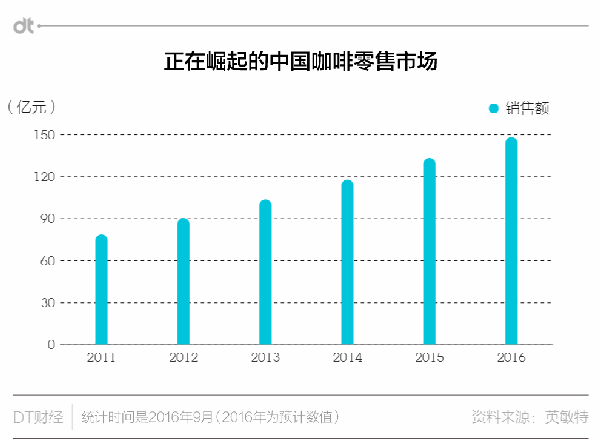
It is precisely because of a strong sense of this "new trend" that convenience stores have shown great enthusiasm for freshly ground coffee.
In addition to more and more convenience stores offering and vigorously promoting freshly ground coffee, many convenience stores have placed freshly ground coffee menus directly above the cashier-the area where it is easiest to look at when you are waiting in line to check out. They even hung coffee signs outside the store.

(photo caption: in front of many family convenience stores, promotional photos taken by Chen Yihan for his freshly ground coffee brand "Guoker"; source: uploaded by netizens on Sina Weibo)
Lattes are the most popular in this "emerging market"
However, convenience stores play in a completely different way from Starbucks.
If you pay attention to the coffee menus in convenience stores, you will find that they are all in simplified mode.
Latte and American style, the two most basic flavors, are "standard" on the coffee menus of several convenience stores in a combination equivalent to Starbucks medium. But if you want a popular "Flat White", you may have to move to the coffee shop.
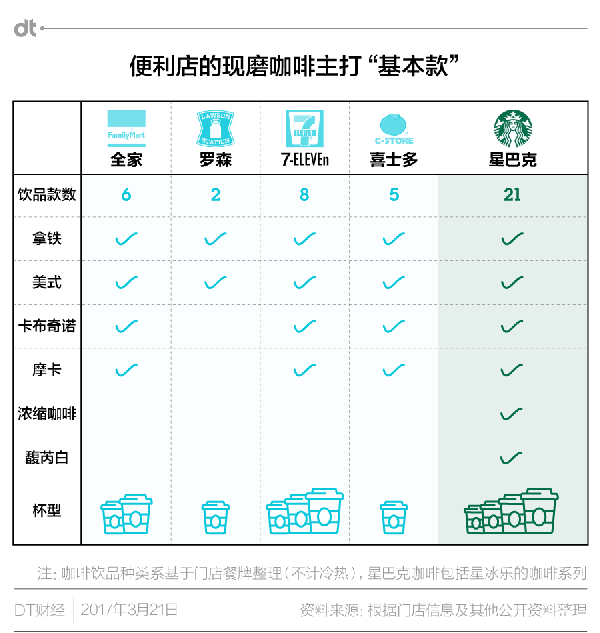
Compared with professional coffee shops, the reason for the simplified coffee menu in convenience stores is simple: they are aimed at office workers in fast-paced cities, who buy coffee more based on rigid needs than "split sentiment".
"We are not a professional coffee shop, and customers do not come here for impulse consumption, they tend to think about what they want before buying." Wu Yilan, senior director of the Rosen Commodity Department, explained.
The "basic model" strategy worked well.
According to DT's survey of the four convenience stores pictured above, their "top sellers" are all lattes-the basic model of this milk coffee, which also means classics and popularity in China.
According to a survey conducted by Mintel, a market research firm, in June 2016, 57 per cent of the nearly 3000 Chinese consumers surveyed preferred milk coffee and 27 per cent preferred black coffee. Generally speaking, the more mature the coffee market is, the more consumers like the taste of coffee itself, and the black coffee represented by American style is more popular. As a new coffee market in China, milk coffee is more popular here.
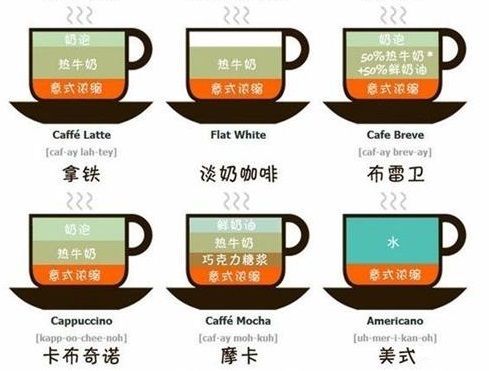
(photo caption: description of the ingredients of different coffee)
Moreover, the basic model not only better matches the needs of consumers, but also makes convenience store staff easier to operate.
A head of the coffee business in East China described to Mr. DT the caution of launching flavored coffee: in the past few years, Histo has launched several flavored coffee with syrup, but these new models were eventually stopped because of the difficulty of syrup hygiene maintenance and the inconvenience of standardized operation. She also noticed that the whole family had not launched much new coffee products in the last year.
"not bad" is more meaningful than "delicious".
Another major selling point of freshly ground coffee in convenience stores is the ratio of performance to price, which is mainly reflected in the materials and price.
After grilling, Mr. DT has to say that coffee production in convenience stores may be more professional than some coffee shops on the market that claim to be professional.
Coffee machines all come from Switzerland, Italy and Germany, which are famous for their high-quality models in European countries, and the price is generally more than 50,000 yuan. Histo simply used TIGER from the same factory as the Starbucks coffee maker. In addition, German brands such as WMF, which are modular, compact and more durable, will be more popular because of the high standards of speed and flow in convenience stores.
When it comes to coffee beans, Arabica beans, which are often talked about by Starbucks, are also popular in convenience stores.
Here is the simple science popularization of DT:
Arabica beans are not rare. On the contrary, Arabica beans are the most mainstream coffee bean species in the global coffee market (the output is close to 70% of the global coffee beans). They generally grow above 1000 meters above sea level and are famous for their low caffeine, high sugar content and more flavor substances. the taste far exceeds that of Robbata beans used in instant and canned coffee.
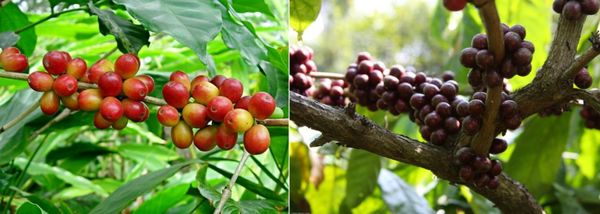
(photo caption: Arabica on the left, Robusta on the right)
In addition, Histo and Rosen also know how to improve the quality of coffee through cooperation with professional partners such as illy and UCC, a well-known coffee company.
As for milk, as mentioned above, because the Chinese people prefer milk coffee, people will have a higher demand for milk and foam. In this regard, in addition to the raw milk emphasized by several major convenience stores, you can also see from the picture below that the whole family and 7-ELEVEn use fresh milk with a better taste, so that even if you are picky, you can't drink milk fishy:
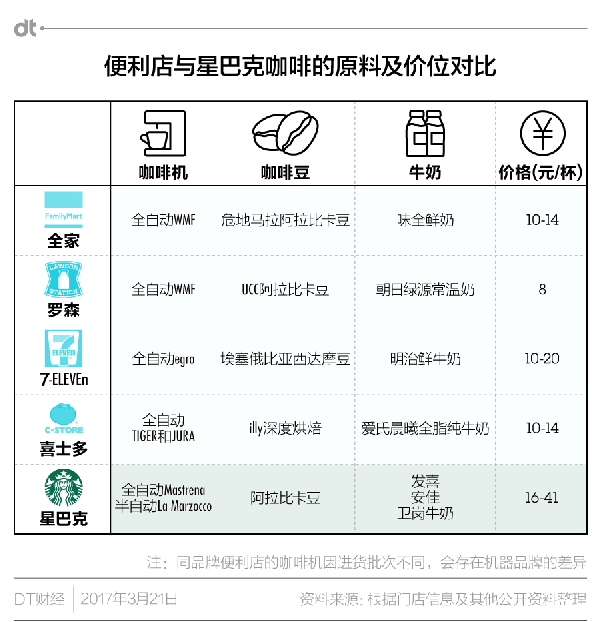
The quality looks similar to that of Starbucks, but the price of convenience store coffee is only as low as that of Starbucks, which doesn't mean it's unprofitable.
The head of the coffee business in eastern China analyzed to Mr. DT that in terms of commodities alone, the gross profit margin of Starbucks coffee is close to 90%, while convenience store coffee can reach more than 50%.
On the premise of this profit, convenience stores tacitly set their prices at about 1.5 times the price of cans-a carefully evaluated strategy.
As far as you are concerned, the account has to be calculated like this:
When coffee is no longer an X prop for posting moments and a necessary supply for work, buying a cup of Starbucks may cost an extra 20 yuan for the environment. 20 cups a month is 400 yuan, and a year is 4800 yuan-this is the price-to-performance logic that convenience stores want to sell to you.
Besides, when coffee sells for ten yuan a cup, you probably won't be too picky about its taste.
Open a shop first, then sell coffee
As you can see, unlike Starbucks who seek boutique development and emphasize the social functions of the "third space" of cafes (spaces outside their homes and units), convenience store coffee takes a more "rigid demand" path-focusing on consumers who pursue speed, convenience and cost-effectiveness.
You may be one of these people: in and out of urban office buildings and business circles, or with a returnee degree, or working in a foreign company, a relatively mature coffee party with a more inclusive understanding of coffee and western culture. The above-mentioned Mintel survey also shows that in China, this group of people who drink coffee as a routine already account for 53% of coffee consumers.
Does that sound good?
But the truth is that the new business of convenience store coffee has just started in China, and its popularity depends on the increase in the density of convenience stores themselves-if coffee is not readily available, the significance of speed and convenience cannot be realized.
In Taiwan, where coffee culture is more developed, the "cafe" with the largest market share is actually 7muri Elevenmuri, a convenience store giant that accounts for half of Taiwan's convenience store industry, with more than 5000 stores.
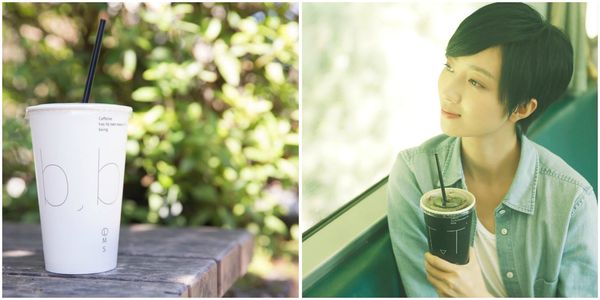
(photo caption: Gui Lun magnesium shot a video advertisement for 7-ELEVEn freshly ground coffee last year, the theme is about the growth and farewell of white-collar workers in the workplace.)
The number of convenience stores on the mainland is obviously not enough. According to the 2016 China Urban convenience Store Index, an average of 2300 people in Taiwan and Japan own a convenience store, compared with just over 3400 in Shanghai, which is famous for its convenience stores.
At present, the whole family, which is the most active in building convenience store coffee brands, has only opened nearly 1900 stores on the mainland, lagging behind Starbucks. In other words, "meeting a nice cup of convenience store coffee around the corner" is not nearly as easy as meeting Starbucks around the corner.
But convenience stores are already speeding up.
According to an earlier report by thepaper.cn, the family plans to expand its stores in the mainland to 4500 by 2020, and Rosen said he hopes to quadruple the current number (750at the time).
In terms of coffee, according to Mr. DT, the whole family has realized coffee stores in Shanghai to cover most communities, offices, and business areas, and has expanded its freshly ground coffee product line to all nine cities covered by the brand. Rosen plans to expand the number of coffee stores from 100 to 300 this year, while Histo plans to increase its long-term goal of coffee stores from 50% to 80%. The momentum is advancing by leaps and bounds.
After all, if convenience stores want coffee to sell well, they can't just wait for Xing Dad to open up the market, but also have to start their own efforts to ripen the market.
Important Notice :
前街咖啡 FrontStreet Coffee has moved to new addredd:
FrontStreet Coffee Address: 315,Donghua East Road,GuangZhou
Tel:020 38364473
- Prev
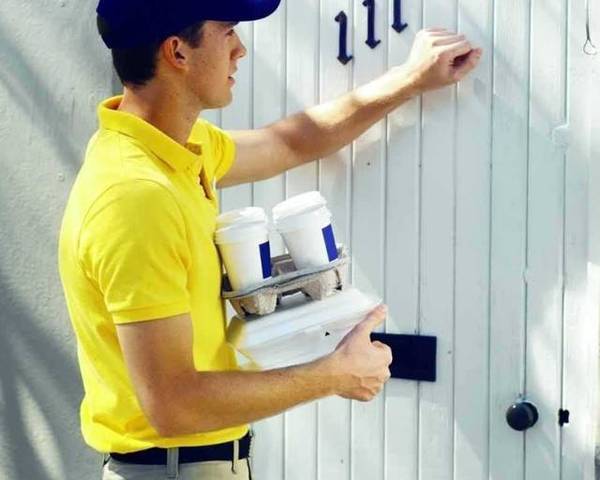
Can this new scene of "bike sharing" in the catering industry bring about a revolution in the business model?
Mobike and ofo bicycles have become the hottest new game of Internet sharing economy, which is actually based on scene reconstruction. Wu Sheng, a famous self-media man, once concluded that the scene has become one of the few opportunities for the transformation of traditional industries in the "scene Revolution". The bicycle economy confirms this judgment. Diners often become pioneers of the new economic model without knowing it that the catering industry
- Next
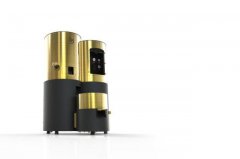
Stronghold Zhike participated in the coffee exhibition and the new product was released as the focus of the exhibition.
Stronghold (Shanghai) Trading Co., Ltd., a global leader in coffee roasting solutions, participated in the 2017 High-end Food and Beverage Exhibition held at the Shanghai New International Expo Center. Its brand Stronghold Zhibao Coffee Roaster S8 doree (Dorey) was officially unveiled at the new product launch.
Related
- What is the difference between a cake filter cup and a V60 conical filter cup? What are the advantages and disadvantages of the flat-bottomed filter cup brewing solution?
- What is the difference between fine coffee powder and medium coarse coffee powder? Do I need to sift out the fine coffee powder for making coffee by hand?
- Why does hot American coffee taste bitter? Difference in proportional concentration between hot American and ice American
- Is espresso stored overnight in the refrigerator harmful to your body? Is frozen coffee better than freshly ground coffee?
- What parameters and proportions of water temperature should be used to grind and brew fresh coffee beans? Why can't I drink freshly roasted coffee right away?
- Customers have "changed" Manner's new products! Shop assistant: Please don't mess around!
- Remove sockets in customer areas at Starbucks stores?! Netizen: I won't go if I really tear it down
- What is the difference between the taste steps of sun-dried coffee and washed coffee? Why is sun-cured coffee sweeter and washed coffee sour?
- The recipe for salty grapefruit dirty is revealed! Coffee Festival salty grapefruit dirty coffee making materials parameters ratio milk share!
- How about the flavor of Sunlight 74158 at Sidamo Banshaha Mathieu Processing Factory in Ethiopia? 74158 Share the proportion of coffee brewing parameters!

